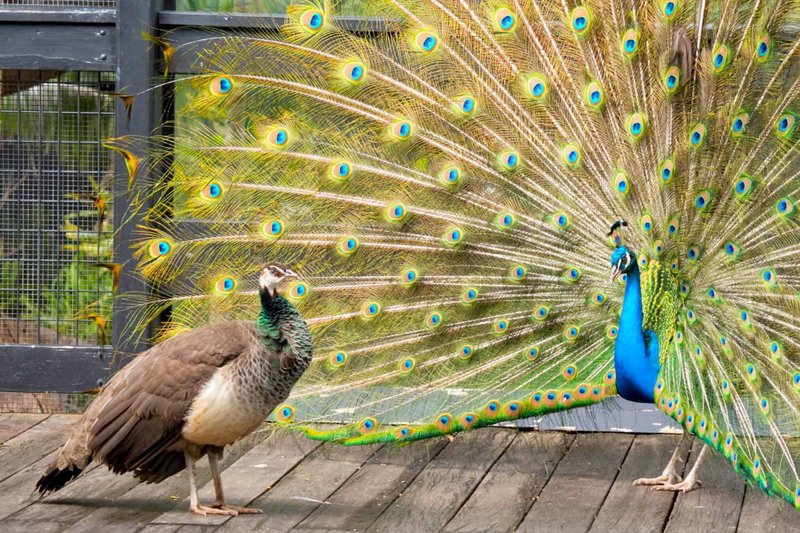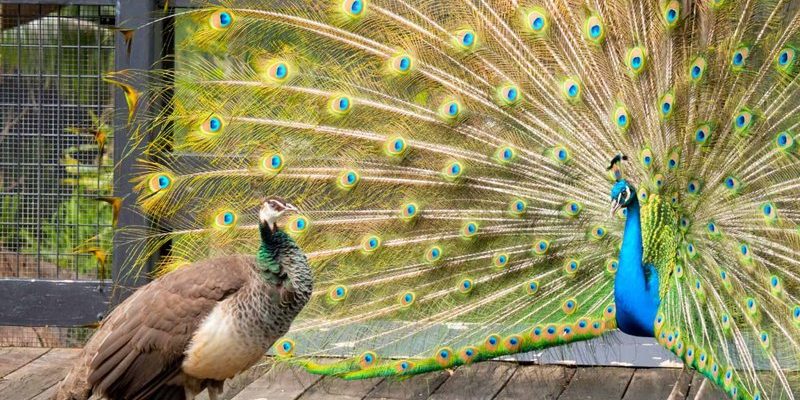
Peacocks mainly inhabit forests, grasslands, and even rural areas in countries like India, Sri Lanka, and parts of Africa. They are not just pretty birds; they are intelligent creatures that have developed several adaptations for survival. So, how exactly do these magnificent birds manage to thrive where they do? Let’s dive into the world of peacocks and explore their incredible adaptations to their environment.
Physical Adaptations: More Than Just Beautiful Feathers
When watching a peacock, the first thing that catches your eye is its vibrant feathers. But those dazzling displays serve a purpose beyond looks. Their feathers are not just for show; they play a crucial role in attracting mates and deterring predators. Males have evolved these elaborate tails to signal their health and genetic fitness. The bigger and more colorful the tail, the more attractive it is to female peafowls.
Here’s the thing: behind that beauty lies a practical side. The feathers are also a form of camouflage. When a peacock folds its tail, the patterns can help it blend into the natural environment. This way, it becomes less visible to predators like snakes or big cats lurking nearby. So, what seems like a flamboyant display is, in reality, a smart survival tactic.
Another interesting physical adaptation is the *strong legs and large size* of peacocks. They can run swiftly to escape danger when needed. Their strong legs also help them forage for food, climbing trees or tall shrubs to reach fruits and seeds. Not to forget, those sharp claws add a bit of extra protection against threats.
Behavioral Adaptations: Smart Moves for Survival
Peacocks are not just pretty; they’re also clever! Their behaviors significantly enhance their chances of survival. For instance, they often walk in groups called *mobs*. This social behavior provides safety in numbers. You might think of it as having a buddy system in the wild. When they’re together, it’s harder for a predator to single out one bird.
Another fascinating behavior is their *vigilance*. Peacocks are highly alert and constantly scan their surroundings for danger. If one member of the group spots a potential threat, it makes loud calls to warn the others. These calls can range from a sharp “ka-ow” to a softer “honk,” depending on the situation. This alarm system is vital for their survival, ensuring the entire group can react quickly.
You might be wondering how peacocks deal with changing environments. They’re remarkable at adapting their behavior based on the season and location. For example, in dryer regimes, they might shift their foraging patterns to find water sources. Meanwhile, in areas where food is scarce, they can travel longer distances to find sustenance. This flexibility is key to their resilience.
Dietary Adaptations: What’s on the Menu?
Peacocks have a varied diet that plays a significant role in their adaptability. They are omnivores, meaning they eat both plants and animals. Their diet typically consists of:
- Grains
- Seeds
- Fruits
- Insects
- Small reptiles
This broad menu allows them to thrive in various habitats. Depending on what’s available and in season, peacocks can easily switch their diet. For example, in a lush forest, they might feast on fruits and seeds from trees. In a dryer environment, they may rely more on insects or small animals.
Here’s the thing: their eating habits also reflect their social structure. When peacocks forage together, they can cover more ground and find food more efficiently. Their loud calls help communicate with each other while searching for tasty treats. It’s a clever way to combine efforts for survival.
Habitat Adaptations: Finding the Right Home
Peacocks usually prefer mixed environments with plenty of cover, like forests or grasslands near water sources. But they can adapt to different settings, even urban areas. This versatility allows them to thrive in various environments, which is a big plus for their survival.
One way they adapt is by choosing spots that offer safety and food. For example, in a forest, they might select areas with dense underbrush to shield themselves from predators. In urban settings, they often take advantage of gardens and parks, where they can find food scraps and enjoy a little human activity.
Interestingly, peacocks also use their surroundings to create nests. They typically nest on the ground, using grasses and leaves to form a safe spot for their eggs. This proves clever, as their natural camouflage helps protect the nest from potential threats.
Breeding Adaptations: The Dance of Courtship
During the breeding season, male peacocks go all out to attract a mate. It’s similar to a talent show, where only the most impressive acts earn applause. The males display their beautiful tail feathers, creating a fan that’s full of iridescent colors. They also perform elaborate courtship dances, including spreading their feathers and making distinct calls.
This display is not just about beauty; it also shows off their health. A peacock with vibrant feathers and strong postures signals good genes, making it more desirable for the females. Interestingly, females often choose their mates based on these displays, which drives the evolution of even more extravagant traits.
Mating season is a crucial time for peacocks. They tend to stay close to water bodies, where food is abundant and predators are fewer. This strategic choice allows them to focus on breeding while minimizing risks.
Challenges of Adaptation: Facing a Changing World
Despite their impressive adaptations, peacocks face numerous challenges in today’s world. Habitat loss due to urbanization and deforestation threatens their natural homes. As their environments shrink, competition for resources increases, making survival more difficult.
Another challenge is poaching. Peacocks are hunted for their beautiful feathers and meat, impacting their population in certain areas. Conservation efforts are essential to protect these magnificent birds from extinction.
Honestly, it’s a lot like juggling. Peacocks must constantly balance their adaptations with the changing world around them. They rely on their remarkable skills to navigate and continue thriving, but they need our help to ensure their future.
Final Thoughts on Peacock Adaptations
Peacocks are more than just a pretty face in the animal kingdom. Their adaptations to their environment are a remarkable blend of beauty, intelligence, and survival strategies. From their vibrant feathers to their social behaviors and eating habits, peacocks have evolved to thrive where they are.
As we learn more about these fascinating birds, it’s a reminder of the importance of protecting their habitats and ensuring they continue to flourish. After all, in a world that’s constantly changing, it’s the unique adaptations of creatures like peacocks that can inspire us all.

